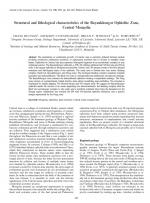Добрый день, Коллеги. Важное сообщение, просьба принять участие. Музей Ферсмана ищет помощь для реставрационных работ в помещении. Подробности по ссылке
Structural and lithological characteristics of the Bayankhongor Ophiolite Zone, Central Mongolia
The mechanism of continental growth of Central Asia is currently debated between models invoking continuous subduction–accretion, or punctuated accretion due to closure of multiple ocean basins. Ophiolites in Central Asia may represent offscraped fragments in an accretionary complex or true collisional sutures. The Bayankhongor ophiolite, a NW–SE-striking sublinear belt 300 km long and 20 km wide, is the largest ophiolite in Mongolia and possibly Central Asia. We present results of the first detailed structural and lithological study of the ophiolite. The study area is divided into four zones: Baidrag complex, Burd Gol, Bayankhongor, and Dzag zones. The Archaean Baidrag complex comprises tonalitic granulites and metasediments. The Burd Gol zone is a metamorphosed sedimentary and igneous me´lange. The Bayankhongor zone contains the dismembered ophiolite forming a serpentinite me´lange. The Dzag zone consists of asymmetrically folded chlorite–mica schists resembling meta-turbidites. The structure is dominated by steeply dipping, NE directed thrusts and NE-vergent folds. We suggest the Bayankhongor ophiolite marks the closure of an ocean separating two microcontinents: the Baidrag complex with the Burd Gol accretionary complex to the south, and a northern continent that forms the basement for the Hangai region. Subduction was towards the SW with NE-directed ophiolite obduction onto a passive margin represented by the Dzag zone.




